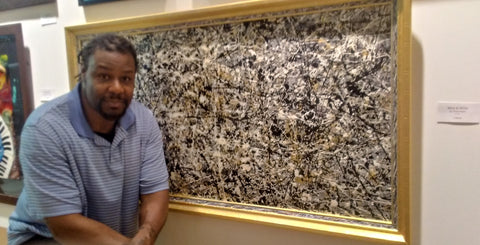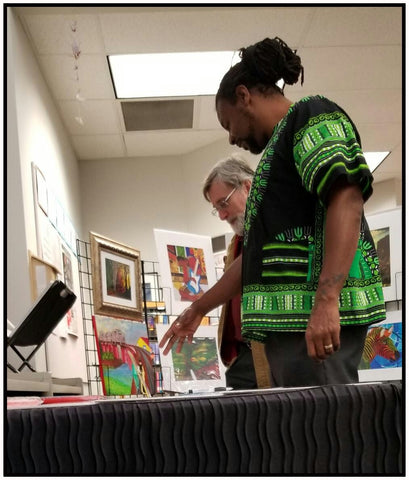Art collecting can be called an art onto itself, and I should say there is no right way to buy art! Art is a personal thing and you should always buy what you fall in love with or what excites you. Yes, there are many styles, names, trends and some art goes up faster than others. Art can be very trendy and people may be talking about this artist more than that one. But somewhere between fine wine and investments is where you can find fine art.
Art As An Investment
The basics of art as an investment is that you purchase a piece of art that you're passionate about and in time the artist, gallery, or art house start selling that artist's artwork for more than what you paid for it. Voila! you now have equity in your piece of art, keeping in mind there are many factors to how fast the equity grows and demand for that particular artist. A friend of mine sometimes uses her collection as currency, trading artworks for other things she needs. She has used this method to buy cars, pay bills and dinner. The real value in art is finding other people that are as passionate about that artist as you are. Because of this, if you own the right pieces of art it can be leveraged by sharing it with the world. Corporations, museums and traveling exhibitions lease these kinds of artworks all the time which provide income for the owners. But If you want a guarantee on your art buying... then I suggest you buy art for love, you'll always get your value out of it.
Do Your Research
Spend some time learning about the artwork and the artist because trends and popularity can both be misleading. Whenever possible, buy art in person and even better meet with the artist. Ask them about the series if it is in one, ask what is the size of it and if they plan on continuing the series. At some point, you may plan to buy another artwork and it would be good to know if there will be more in that style. If you have the pleasure of talking to the artist, try to find out if they do art fulltime, where they will be showing next and what projects are coming up next. A lot of artists do studio sales, that help control their inventory, sale one-off pieces, and earn them additional income. Knowing when these artists are having their studio sales can normally save you a lot of cash, plus you get to hang-out in the studio. Research can be a collector's best friend.
Collect with a Focus
This is a hard one for new collectors because they have not set any parameters yet. You do not need to limit yourself to just one type of work. Focus on a style or two or three styles, this will really help you build a great collection. This type of collecting helps to make it easier for identifying the kinds of works you want to purchase.
Proper Title Transfer
Any reputable art dealer or gallery should provide you with things like the provenance, condition, artist information with signature, history and edition numbers.
Documentation Is King
As a collector, you need to have all the documentation for your collection. Because anyone that needs to evaluate your collection must have a very thorough understanding of all the pieces. From your very first artwork you purchase, start a list of all the works, descriptions, invoices of sale prices, the purchase dates, and subsequent appraisal prices. It's a good practice and will save you so many headaches in the future.
One of the simplest ways to learn more about an artwork or an artist is to ask questions, have fun and happy collecting.
Website: http://www.vincentkeele.com
5 Things Every New Collector Needs to Know
Art collecting can be called an art onto itself, and I should say there is no right way to buy art! Art is a personal thing and you should always buy what you fall in love with or what excites you. Yes, there are many styles, names, trends and some art goes up faster than others. Art can be very trendy and people may be talking about this artist more than that one. But somewhere between fine wine and investments is where you can find fine art.
Art As An Investment
The basics of art as an investment is that you purchase a piece of art that you're passionate about and in time the artist, gallery, or art house start selling that artist's artwork for more than what you paid for it. Voila! you now have equity in your piece of art, keeping in mind there are many factors to how fast the equity grows and demand for that particular artist. A friend of mine sometimes uses her collection as currency, trading artworks for other things she needs. She has used this method to buy cars, pay bills and dinner. The real value in art is finding other people that are as passionate about that artist as you are. Because of this, if you own the right pieces of art it can be leveraged by sharing it with the world. Corporations, museums and traveling exhibitions lease these kinds of artworks all the time which provide income for the owners. But If you want a guarantee on your art buying... then I suggest you buy art for love, you'll always get your value out of it.
Do Your Research
Spend some time learning about the artwork and the artist because trends and popularity can both be misleading. Whenever possible, buy art in person and even better meet with the artist. Ask them about the series if it is in one, ask what is the size of it and if they plan on continuing the series. At some point, you may plan to buy another artwork and it would be good to know if there will be more in that style. If you have the pleasure of talking to the artist, try to find out if they do art fulltime, where they will be showing next and what projects are coming up next. A lot of artists do studio sales, that help control their inventory, sale one-off pieces, and earn them additional income. Knowing when these artists are having their studio sales can normally save you a lot of cash, plus you get to hang-out in the studio. Research can be a collector's best friend.
Collect with a Focus
This is a hard one for new collectors because they have not set any parameters yet. You do not need to limit yourself to just one type of work. Focus on a style or two or three styles, this will really help you build a great collection. This type of collecting helps to make it easier for identifying the kinds of works you want to purchase.
Proper Title Transfer
Any reputable art dealer or gallery should provide you with things like the provenance, condition, artist information with signature, history and edition numbers.
Documentation Is King
As a collector, you need to have all the documentation for your collection. Because anyone that needs to evaluate your collection must have a very thorough understanding of all the pieces. From your very first artwork you purchase, start a list of all the works, descriptions, invoices of sale prices, the purchase dates, and subsequent appraisal prices. It's a good practice and will save you so many headaches in the future.
One of the simplest ways to learn more about an artwork or an artist is to ask questions, have fun and happy collecting.
Website: http://www.vincentkeele.com
5 Things Every New Collector Needs to Know
Article Source: http://EzineArticles.com/9848860
Art collecting can be called an art onto itself, and I should say there is no right way to buy art! Art is a personal thing and you should always buy what you fall in love with or what excites you. Yes, there are many styles, names, trends and some art goes up faster than others. Art can be very trendy and people may be talking about this artist more than that one. But somewhere between fine wine and investments is where you can find fine art.
Art As An Investment
The basics of art as an investment is that you purchase a piece of art that you're passionate about and in time the artist, gallery, or art house start selling that artist's artwork for more than what you paid for it. Voila! you now have equity in your piece of art, keeping in mind there are many factors to how fast the equity grows and demand for that particular artist. A friend of mine sometimes uses her collection as currency, trading artworks for other things she needs. She has used this method to buy cars, pay bills and dinner. The real value in art is finding other people that are as passionate about that artist as you are. Because of this, if you own the right pieces of art it can be leveraged by sharing it with the world. Corporations, museums and traveling exhibitions lease these kinds of artworks all the time which provide income for the owners. But If you want a guarantee on your art buying... then I suggest you buy art for love, you'll always get your value out of it.
Do Your Research
Spend some time learning about the artwork and the artist because trends and popularity can both be misleading. Whenever possible, buy art in person and even better meet with the artist. Ask them about the series if it is in one, ask what is the size of it and if they plan on continuing the series. At some point, you may plan to buy another artwork and it would be good to know if there will be more in that style. If you have the pleasure of talking to the artist, try to find out if they do art fulltime, where they will be showing next and what projects are coming up next. A lot of artists do studio sales, that help control their inventory, sale one-off pieces, and earn them additional income. Knowing when these artists are having their studio sales can normally save you a lot of cash, plus you get to hang-out in the studio. Research can be a collector's best friend.
Collect with a Focus
This is a hard one for new collectors because they have not set any parameters yet. You do not need to limit yourself to just one type of work. Focus on a style or two or three styles, this will really help you build a great collection. This type of collecting helps to make it easier for identifying the kinds of works you want to purchase.
Proper Title Transfer
Any reputable art dealer or gallery should provide you with things like the provenance, condition, artist information with signature, history and edition numbers.
Documentation Is King
As a collector, you need to have all the documentation for your collection. Because anyone that needs to evaluate your collection must have a very thorough understanding of all the pieces. From your very first artwork you purchase, start a list of all the works, descriptions, invoices of sale prices, the purchase dates, and subsequent appraisal prices. It's a good practice and will save you so many headaches in the future.
One of the simplest ways to learn more about an artwork or an artist is to ask questions, have fun and happy collecting.
Website: http://www.vincentkeele.com
5 Things Every New Collector Needs to Know



 Learn More About The Art
Learn More About The Art